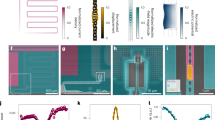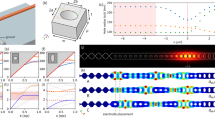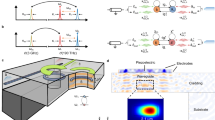Abstract
An interface between microwave and optical photons offers the potential to network remote superconducting quantum processors. To preserve fragile quantum states, a microwave-to-optical transducer must operate efficiently in the quantum-enabled regime by generating less than one photon of noise referred to its input. Here we achieve these criteria using an integrated electro-optomechanical device made from crystalline silicon. Our platform eliminates the need for heterogeneous integration with piezoelectric materials by utilizing electrostatic actuation of gigahertz-frequency nanomechanical oscillators. Leveraging the ultra-low mechanical dissipation in silicon, our microwave-to-optical transducers achieve below one photon of input-referred added noise (nadd = 0.58) under continuous-wave laser drives. This demonstration of continuous quantum-enabled microwave-to-optical transduction improves the upconversion rate by about two orders of magnitude beyond the state of the art (R = 0.47–1.9 kHz). The increased transduction rate and scalable fabrication of our devices may facilitate near-term use of transducers in distributed quantum computers and quantum networks.
This is a preview of subscription content, access via your institution
Access options
Access Nature and 54 other Nature Portfolio journals
Get Nature+, our best-value online-access subscription
$32.99 / 30 days
cancel any time
Subscribe to this journal
Receive 12 print issues and online access
$259.00 per year
only $21.58 per issue
Buy this article
- Purchase on SpringerLink
- Instant access to full article PDF
Prices may be subject to local taxes which are calculated during checkout




Similar content being viewed by others
Data availability
The source data in the figures that support the findings of this study are available via Zenodo at https://doi.org/10.5281/zenodo.14743911 (ref. 58). Other data that support the findings of this study are available from the corresponding authors upon reasonable request.
References
Kimble, H. J. The quantum internet. Nature 453, 1023 (2008).
Gisin, N. & Thew, R. Quantum communication. Nat. Photon. 1, 165 (2007).
Kurizki, G. et al. Quantum technologies with hybrid systems. Proc. Natl Acad. Sci. USA 112, 3866 (2015).
Han, X. et al. Microwave-optical quantum frequency conversion. Optica 8, 1050 (2021).
Wehner, S., Elkouss, D. & Hanson, R. Quantum internet: a vision for the road ahead. Science 362, eaam9288 (2018).
Awschalom, D. et al. Development of quantum interconnects (QuICs) for next-generation information technologies. PRX Quantum 2, 017002 (2021).
Zeuthen, E., Schliesser, A., Sørensen, A. S. & Taylor, J. M. Figures of merit for quantum transducers. Quantum Sci. Technol. 5, 034009 (2020).
Kumar, A. et al. Quantum-enabled millimetre wave to optical transduction using neutral atoms. Nature 615, 614–619 (2023).
Sahu, R. et al. Quantum-enabled operation of a microwave-optical interface. Nat. Commun. 13, 1276 (2022).
Horsman, D., Fowler, A. G., Devitt, S. & Van Meter, R. Surface code quantum computing by lattice surgery. New J. Phys. 14, 123011 (2012).
Andrews, R. W. et al. Bidirectional and efficient conversion between microwave and optical light. Nat. Phys. 10, 321 (2014).
Brubaker, B. M. et al. Optomechanical ground-state cooling in a continuous and efficient electro-optic transducer. Phys. Rev. X 12, 021062 (2022).
Sahu, R. et al. Entangling microwaves with light. Science 380, 718 (2023).
Fan, L. et al. Superconducting cavity electro-optics: a platform for coherent photon conversion between superconducting and photonic circuits. Sci. Adv. 4, eaar4994 (2018).
McKenna, T. P. et al. Cryogenic microwave-to-optical conversion using a triply resonant lithium-niobate-on-sapphire transducer. Optica 7, 1737 (2020).
Holzgrafe, J. et al. Cavity electro-optics in thin-film lithium niobate for efficient microwave-to-optical transduction. Optica 7, 1714 (2020).
Fu, W. et al. Cavity electro-optic circuit for microwave-to-optical conversion in the quantum ground state. Phys. Rev. A 103, 053504 (2021).
Xu, Y. et al. Bidirectional interconversion of microwave and light with thin-film lithium niobate. Nat. Commun. 12, 1 (2021).
Bartholomew, J. G. et al. On-chip coherent microwave-to-optical transduction mediated by ytterbium in YVO4. Nat. Commun. 11, 1 (2020).
Rochman, J., Xie, T., Bartholomew, J. G., Schwab, K. C. & Faraon, A. Microwave-to-optical transduction with erbium ions coupled to planar photonic and superconducting resonators. Nat. Commun. 14, 1 (2023).
Xie, T., Fukumori, R., Li, J. & Faraon, A. Scalable microwave-to-optical transducers at single photon level with spins. Preprint at https://arxiv.org/abs/2407.08879 (2024).
Zhu, N. et al. Waveguide cavity optomagnonics for microwave-to-optics conversion. Optica 7, 1291 (2020).
Arnold, G. et al. Converting microwave and telecom photons with a silicon photonic nanomechanical interface. Nat. Commun. 11, 1 (2020).
Mirhosseini, M., Sipahigil, A., Kalaee, M. & Painter, O. Superconducting qubit to optical photon transduction. Nature 588, 599 (2020).
Jiang, W. et al. Optically heralded microwave photon addition. Nat. Phys. 19, 1423 (2023).
Weaver, M. J. et al. An integrated microwave-to-optics interface for scalable quantum computing. Nat. Nanotechnol. 19, 166 (2024).
Meesala, S. et al. Non-classical microwave-optical photon pair generation with a chip-scale transducer. Nat. Phys. 20, 871–877 (2024).
Meesala, S. et al. Quantum entanglement between optical and microwave photonic qubits. Phys. Rev. X 14, 031055 (2024).
Scigliuzzo, M. et al. Phononic loss in superconducting resonators on piezoelectric substrates. New J. Phys. 22, 053027 (2020).
Meenehan, S. M. et al. Silicon optomechanical crystal resonator at millikelvin temperatures. Phys. Rev. A 90, 011803 (2014).
Bozkurt, A. et al. A quantum electromechanical interface for long-lived phonons. Nat. Phys. 19, 1326 (2023).
MacCabe, G. S. et al. Nano-acoustic resonator with ultralong phonon lifetime. Science 370, 840 (2020).
Aspelmeyer, M., Kippenberg, T. J. & Marquardt, F. Cavity optomechanics. Rev. Mod. Phys. 86, 1391 (2014).
Chan, J., Safavi-Naeini, A. H., Hill, J. T., Meenehan, S. & Painter, O. Optimized optomechanical crystal cavity with acoustic radiation shield. Appl. Phys. Lett. 101, 081115 (2012).
Zhao, H., Bozkurt, A. & Mirhosseini, M. Electro-optic transduction in silicon via gigahertz-frequency nanomechanics. Optica 10, 790 (2023).
Bretz-Sullivan, T. M. et al. High kinetic inductance NbTiN superconducting transmission line resonators in the very thin film limit. Appl. Phys. Lett. 121, 052602 (2022).
Shearrow, A. et al. Atomic layer deposition of titanium nitride for quantum circuits. Appl. Phys. Lett. 113, 212601 (2018).
Xu, M., Han, X., Fu, W., Zou, C.-L. & Tang, H. X. Frequency-tunable high-Q superconducting resonators via wireless control of nonlinear kinetic inductance. Appl. Phys. Lett. 114, 192601 (2019).
Lobo, R. P. S. M. et al. Photoinduced time-resolved electrodynamics of superconducting metals and alloys. Phys. Rev. B 72, 024510 (2005).
Meenehan, S. M. et al. Pulsed excitation dynamics of an optomechanical crystal resonator near its quantum ground state of motion. Phys. Rev. X 5, 041002 (2015).
Stockill, R. et al. Gallium phosphide as a piezoelectric platform for quantum optomechanics. Phys. Rev. Lett. 123, 163602 (2019).
Ren, H. et al. Two-dimensional optomechanical crystal cavity with high quantum cooperativity. Nat. Commun. 11, 1 (2020).
Ramp, H. et al. Elimination of thermomechanical noise in piezoelectric optomechanical crystals. Phys. Rev. Lett. 123, 093603 (2019).
Kalaee, M. et al. Quantum electromechanics of a hypersonic crystal. Nat. Nanotechnol. 14, 334 (2019).
Jiang, W. et al. Lithium niobate piezo-optomechanical crystals. Optica 6, 845 (2019).
Forsch, M. et al. Microwave-to-optics conversion using a mechanical oscillator in its quantum ground state. Nat. Phys. 16, 69 (2020).
Joe, G. D. et al. High Q-factor diamond optomechanical resonators with silicon vacancy centers at millikelvin temperatures. Nano Lett. 24, 6831–6837 (2024).
Wang, C.-H., Li, F. & Jiang, L. Quantum capacities of transducers. Nat. Commun. 13, 6698 (2022).
Krastanov, S. et al. Optically heralded entanglement of superconducting systems in quantum networks. Phys. Rev. Lett. 127, 040503 (2021).
Zhong, C., Han, X. & Jiang, L. Microwave and optical entanglement for quantum transduction with electro-optomechanics. Phys. Rev. Appl. 18, 054061 (2022).
Niu, J. et al. Low-loss interconnects for modular superconducting quantum processors. Nat. Electron. 6, 235 (2023).
Kolvik, J., Burger, P., Frey, J. & Laer, R. V. Clamped and sideband-resolved silicon optomechanical crystals. Optica 10, 913 (2023).
Sonar, S. et al. High-efficiency low-noise optomechanical crystal photon-phonon transducers. Optica 12, 99–104 (2025).
Mayor, F. M. et al. A two-dimensional optomechanical crystal for quantum transduction. Preprint at https://arxiv.org/abs/2406.14484 (2024).
Bernien, H. et al. Heralded entanglement between solid-state qubits separated by three metres. Nature 497, 86 90 (2013).
Zhong, T. et al. Nanophotonic rare-earth quantum memory with optically controlled retrieval. Science 357, 1392 (2017).
Safavi-Naeini, A. H. Quantum Optomechanics with Silicon Nanostructures. PhD thesis, California Institute of Technology (2013).
Zhao, H., Chen, W. D., Kejriwal, A. & Mirhosseini, M. Data for “Quantum-enabled microwave-to-optical transduction via silicon nanomechanics”. Zenodo https://doi.org/10.5281/zenodo.14743911 (2025).
Acknowledgements
We acknowledge S. Meesala, O. Painter, A. Safavi-Naeini, A. Bozkurt and M. Kalaee for helpful discussions. This work was supported by the ARO/LPS Cross Quantum Technology Systems programme (grant W911NF-18-1-0103), the US Department of Energy Office of Science National Quantum Information Science Research Centers (Q-NEXT, award DE-AC02-06CH11357) and the National Science Foundation (awards 2137645 and 2238058). W.D.C. gratefully acknowledges support from the National Science Foundation Graduate Research Fellowship.
Author information
Authors and Affiliations
Contributions
H.Z., W.D.C. and M.M. came up with the concept and designed the experiment. H.Z., W.D.C. and A.K. worked on the fabrication of the devices. H.Z. and W.D.C. conducted the measurements and analysed the data. All authors participated in the writing of the paper. M.M. supervised the project.
Corresponding author
Ethics declarations
Competing interests
The authors declare no competing interests.
Peer review
Peer review information
Nature Nanotechnology thanks the anonymous reviewers for their contribution to the peer review of this work.
Additional information
Publisher’s note Springer Nature remains neutral with regard to jurisdictional claims in published maps and institutional affiliations.
Extended data
Extended Data Fig. 1 Microwave-to-optical transducer comparison.
Comparison of the transduction rate with the literature. Red dots are the measured rates of our transducer. References: Meesala, 202428; Sahu, 202229; Mirhosseini, 202024; Jiang, 202325; Brubaker, 202212, Weaver, 202327. For Refs. 25,28 (see points with asterisk), we have estimated nadd and next for operation in direct state conversion mode as detailed in supplementary section III. Shaded region denotes the quantum-enabled regime, where nadd < 1. The center points and error bars represent the best-fit value and 95% confidence interval, respectively. See supplementary section II.G and II.H for the models used to fit next. and nadd, respectively.
Extended Data Fig. 2 Measurement setup.
Acronyms: Isolator (Iso), beam splitter (BS), wavelength meter (λ-meter), optical switch (OSw), fiber polarization controller (FPC), band-pass filter (BPF), photodetector (PD), data-acquisition module (DAQ), amplitude modulator (a-m), signal generator (SG), variable optical attenuator (VOA), power meter (p-meter), circulator (Circ), device under test (DUT), phase modulator (ϕ-m), Erbium-doped fiber amplifier (EDFA), delay line (DL), retro-reflector (RR), variable coupler (VC), high-speed photodetector (HSPD), balanced photodetector (BPD), spectrum analyzer (SA), switch (Sw), vector network analyzer (VNA), eccosorb filter (Ecco), low-pass filter (LPF), bias-tee (BT), microwave switch (MSw), high-electron-mobility transistor (HEMT), room-temperature amplifier (RT amplifier).
Extended Data Fig. 3 Fridge setup.
A tuning coil is placed above the device chip to generate magnetic flux that tunes the on-chip microwave resonators. The device chip sits on a printed circuit board (PCB), with the on-chip coplanar waveguides wire-bonded to the PCB traces. The microwave lines are connected to the PCB via MMPX connectors.
Supplementary information
Supplementary Information
Supplementary Figs. 1–8, Discussion and Tables 1 and 2.
Rights and permissions
Springer Nature or its licensor (e.g. a society or other partner) holds exclusive rights to this article under a publishing agreement with the author(s) or other rightsholder(s); author self-archiving of the accepted manuscript version of this article is solely governed by the terms of such publishing agreement and applicable law.
About this article
Cite this article
Zhao, H., Chen, W.D., Kejriwal, A. et al. Quantum-enabled microwave-to-optical transduction via silicon nanomechanics. Nat. Nanotechnol. 20, 602–608 (2025). https://doi.org/10.1038/s41565-025-01874-8
Received:
Accepted:
Published:
Issue date:
DOI: https://doi.org/10.1038/s41565-025-01874-8
This article is cited by
-
Scalable microwave-to-optical transducers at the single-photon level with spins
Nature Physics (2025)



